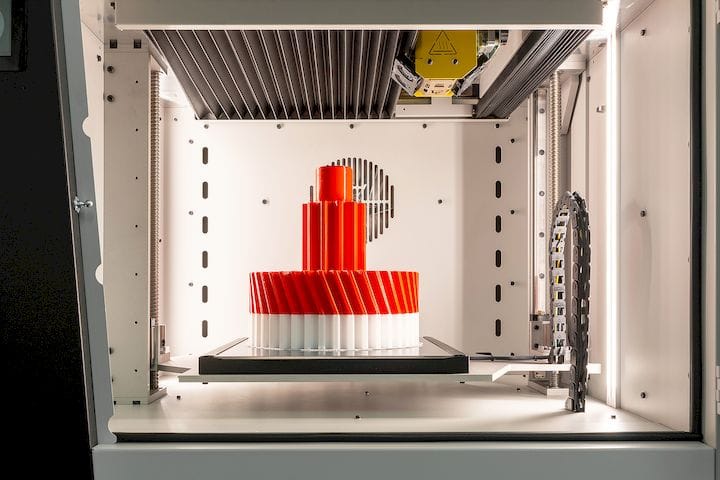![A large 3D print made with the F340’s new HF printing module [Source: 3DGence]](https://fabbaloo.com/wp-content/uploads/2020/05/3dgence-hf-module-ov_result_img_5eb099da73622.jpg)
3DGence announced a new accessory for their popular INDUSTRY F340 professional 3D printer that provides for high flow rates.
The Poland-based company has marketed the F340 for over a year, and its most notable feature is its ability to quickly swap in “printing modules” that enable instantaneous change in printing capabilities. By obtaining the right combination of modules, 3DGence clients can “customize” the machine to meet their needs precisely.
![Swapping in a printing module [Source: 3DGence]](https://fabbaloo.com/wp-content/uploads/2020/05/image-asset_img_5eb099dac07f5.jpg)
These printing modules are easily swapped units that include direct drive extrusion motors, hot end nozzles that match the needs of the specific materials for use, and appropriate cooling fan configurations. By changing the printing module, you instantly change the machine’s abilities.
For some time now, the F340 device allowed three different printing modules, including:
-
PRO: Provides an ability to 3D print basic materials at temperatures less than 265C, including: ABS, PLA, PET, PP, ASA, Nylon, BVOHand HIPS
-
HT: A higher-temperature module rated for materials up to 340C, enabling 3D printing of PC, PC-ABS and PC-ESD
-
HTmax: A very high-temperature module enabling 3D printing of materials up to 500C, including PEEK.
![All four 3DGENCE F340 printing modules, including the new HF module (in yellow) [Source: 3DGence]](https://fabbaloo.com/wp-content/uploads/2020/05/image-asset_img_5eb099db0db91.jpg)
Now the company is introducing a fourth printing module, called “HF”, for “high flow”. The idea here is that for many larger 3D prints there is less need for fine details, and thus using a standard sized nozzle simply adds to the print duration without a lot of benefit. The HF print module includes a 0.6mm nozzle that should dramatically increase the deposition flow rate in the F340 for certain material types. 3DGence says some prints could speed up by as much as 40%.
But it’s much more than just a fat nozzle. They explain:
“HF module was implemented to meet the customer needs which are increasing applications of carbon fiber or glass reinforced materials in their work. Parts manufactured with PA-CF and PA-GF are characterized by increased thermal resistance, but also the hardness and durability. These plastics are commonly used in the injection process in industry and very well known to our customers.”
3DGence has optimized the entire print module around these materials, including not just the nozzle, but also the temperatures, filament path and printing parameters.
![The new HF (High Flow) printing module [Source: 3DGence]](https://fabbaloo.com/wp-content/uploads/2020/05/image-asset_img_5eb099db55d12.jpg)
For some companies, this configuration could be of great use, as the rest of the F340 system is well designed and sports a number of convenience features, such as automatic material recognition through wireless NFC, automated loading, humidity control, air filtration, and dual extrusion for use of soluble support materials.
Initially the HF print module will support PA-CF (carbon fiber), ABS and ASA, but they are expecting to certify PA-GF (glass fiber) by the end of the month. All of these are strong materials that could be of great interest to professionals requiring 3D printing for prototypes or even low volume production.
It’s good to see this addition to 3DGence’s product line, as it will certainly be exactly what some customers require. Also, there’s no sense in having a modular system unless you announce new modules, right?
Via 3DGence











FELIXprinters has released a new bioprinter, the FELIX BIOprinter, which is quite a change for the long-time 3D printer manufacturer.